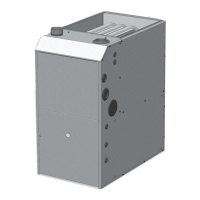W415-0973 / B / 08.28.13
8
IOM
IOM
3.0 FURNACE SIZING
H7.0.2
The maximum hourly heat loss for each heated space shall be calculated in accordance with the procedures
described in the manuals of the Heating, Refrigeration and Air Conditioning Institute of Canada (HRAI), or
by any other method which is suitable for local conditions, provided the results obtained are in substantial
agreement with, and not less than those obtained using the procedure described in their manuals.
In the United States, “Manual J - Load Calculation,” published by the Air Conditioning Contractors of America,
describes a suitable procedure for calculating the maximum hourly heat loss.
If the installation is a retrofi t application, do not rely on the capacity of the existing heating equipment as a
method to size the new furnace. Many of the heat transfer multiples listed in earlier versions of load calculation
manuals were much higher than those listed in more recent editions. It is possible that energy saving
measures have been completed since the installation of the existing furnace. This might include additional
insulation in the attic or walls, the application of sprayed foam insulation, the addition of storm windows and
doors, weather-stripping, caulking, etc.
Many of the older furnaces were equipped with large belt drive blower systems, operating at low RPM’s. If
replacing an existing furnace, be sure that the existing ductwork can handle the amount of airfl ow necessary
for a reasonable temperature rise. Most older gas furnaces operated with a system temperature rise of 70 -
100°F (39 - 56°C). This furnace is designed to be operated with a system temperature rise (∆T) of 35 - 65°F
(20 - 36°C). If the furnace selected has an identical output
capacity as the original furnace, a substantial increase in
system air fl ow will be necessary. See Table 1 and the airfl ow
characteristics in Section 18 of this manual, “Airfl ow”.
Existing ductwork should be assessed for its air handling
capabilities.
The “Equal Friction Chart,” as published by ASHRAE and HRAI, is the basis for the various air duct
calculators available through heating supply companies. Following the air velocity guide lines, according to
the “Equal Friction Chart,” or a slide rule air duct calculator, a typical 6" (152mm) round duct has a capacity of
approximately 100 cfm.
NOTE:
The return air system is equally as important as the supply air system. An under-sized
return air system will prevent suffi cient quantities of air from reaching the supply air
system and will consequently reduce the service life of the furnace and its components.
H12.15.5
TABLE 1 - RANGE OF TEMPERATURE RISE
Furnace Models Temperature Rise
ALL 35 - 65°F (20 - 36°C)

